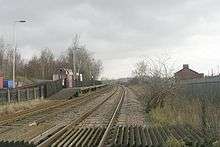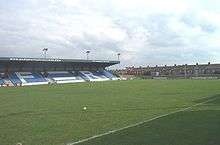Featherstone
| Featherstone | |
 Station Lane |
|
 Featherstone |
|
| Population | 15,244 (2011 census) |
|---|---|
| OS grid reference | SE424206 |
| Civil parish | Featherstone |
| Metropolitan borough | Wakefield |
| Metropolitan county | West Yorkshire |
| Region | Yorkshire and the Humber |
| Country | England |
| Sovereign state | United Kingdom |
| Post town | PONTEFRACT |
| Postcode district | WF7 |
| Dialling code | 01977 |
| Police | West Yorkshire |
| Fire | West Yorkshire |
| Ambulance | Yorkshire |
| EU Parliament | Yorkshire and the Humber |
| UK Parliament | Hemsworth |
Coordinates: 53°42′N 1°22′W / 53.70°N 1.37°W
Featherstone is a town and civil parish in the City of Wakefield in West Yorkshire, England, two miles south-west of Pontefract. In 2011, it had a population of 15,244.[1] Featherstone railway station is on the Pontefract Line.
History
Despite most population growth taking place around the Industrial Revolution, Featherstone traces its history back much further than this. The Domesday Book (1086) records "In Ferestane [Featherstone] and Prestone [Purston] and Arduwic [Hardwick] and Osele [Nostell], Ligulf had 16 carucates of land for geld, and 6 ploughs may be there."[2] It is thought that a local public house, the Traveller's Rest, can trace its origins to the 17th century whilst the Jubilee Hotel is a listed building which once provided a resting place for wealthy Victorians and their horses.
Like many surrounding areas, Featherstone grew around coal mining. Coal had been mined at Featherstone since the 13th century and remains of bell pits can still be seen to the north of Park Lane at North Featherstone. In 1848, the opening of the Wakefield, Pontefract and Goole railway line through Featherstone provided the basis for large scale coal mining in Featherstone, by opening up new markets in the South of England and Europe.
The town came to national attention during a national "lockout" of mine workers.[due to low coal prices and over production] When in 1893 soldiers fired on a crowd, who were demonstrating at the colliery gates, killing two.[3] A distinctive sculpture marking the centenary of the Featherstone Massacre stands in the shopping precinct and a large mural depicting the town's heritage can be seen at the town's main crossroads. Ackton Hall Colliery was the first pit to close following the end of the miners' strike and this could not be contested as geological difficulties had made it impossible for the pit to continue production.
Featherstone is the subject of a study, Coal is Our Life, by the sociologist Norman Dennis, published in 1956.
Opened in the 1950s, Purston Park takes up a large area of space and offers a lake and a children's play area. There was also previously a bowling green, until being changed to a rose garden in 2004. It has been made out of the grounds of what was originally a private residence and a country estate, with the stately home formerly acting as the town hall. This building was sold to developers in 2007 and has since been converted into luxury flats.
Featherstone is undergoing continual change and as part of this a new, state-of-the-art £2.5-million community centre has been built in Station Lane. The "Pit Houses", the houses constituting a council estate which formerly belonged to the National Coal Board, have been demolished to make room for further developments.
Toponymy
Like many place-names in the area, 'Featherstone' derives from Old English. The name is formed of two elements: feother, meaning 'four', and stān, meaning 'stone'. Therefore, the names means "(place at) the four stones". These 'four stones' are likely to have been some waymarker or monument by a road or other well-used route through the town. The settlement was recorded in the Domesday Book of 1086 as Fredestan.[4]
Politics
Featherstone is currently a Labour stronghold. It is part of the Hemsworth constituency, and is represented by Labour MP Jon Trickett in the House of Commons and by three Labour Councillors on Wakefield Council: Richard "Dick" Taylor, Graham Isherwood and Maureen Tennant-King[5] Featherstone Town Council is also controlled by Labour., Cllr Steve Vickers is the Town Mayor for 2016/17
Fighting decline
Starting in the mid-1970s to the mid-1980s, the area went into an era of sharp decline in the residents' quality of life. Historians and social scientists have put forward many factors. The gradual loss of the coal industry coupled with poor housing and education. This has begun to improve in recent years with new housing developments, better schools and plans to breathe life back into the local business community via various climate friendly projects.
Transport
Featherstone has a railway station on the Pontefract Line. There are also bus services operated by Arriva Yorkshire. The M62 lies close by.
Education
The town has two secondary schools, the Featherstone Academy and St Wilfrid's Catholic High School.
Primary and infant schools include St Thomas' Junior, Girnhill Infants', Purston Infants', North Featherstone Junior and Infants' and All Saints Junior and Infants'.
Religion
Featherstone has a number of churches: St Thomas' Church (Anglican) – built from traditional Yorkshire sandstone, St Thomas' Church and the adjacent vicarage were built in the 1870s. Due to a lack of funding the church has no bell tower, and instead the bell hangs outside on the church’s south wall. The original vicarage is now a private residence. All Saints' Church (Anglican), the Methodist church, and the South Featherstone Gospel Hall are also still active churches.
A former Methodist chapel on Wakefield Road has since been turned into an antiques salesroom and the North Featherstone Gospel Hall has been converted into a private dwelling. St Gerard's Roman Catholic Church was closed in the summer of 2008 – meaning Catholics now have to travel to Pontefract to attend services.[6]
Sport
Featherstone Rovers
The town's sport scene is dominated by its local rugby league club, Featherstone Rovers, who have won the Challenge Cup on three occasions, most recently on 7 May 1983, and won the League Championship in 1976–77. Originally made up of local miners, the club was formed in the Railway Hotel in 1902, then re-formed in 1906.[7] They are currently in the Championship, after being promoted in 2007, beating Oldham in the Play-Offs final. In the 2010 season, Rovers finished first in the league table with a 100% away record and claimed the League Leader's Shield. They reached the Championship Grand Final by beating Halifax 46-16 in the Semi-Final, only to be defeated by Halifax in the final on a golden point (22–23).[8] They went one better in 2012 beating Sheffield Eagles 44-4 in the Grand Final to become Champions.
Featherstone Rovers' stadium (historically known as Post Office Road) was renamed the Bigfellas Stadium in 2010, following a sponsorship deal with Pontefract night club Bigfellas.[9]
Featherstone Lions
The amateur side Featherstone Lions also hails from the town and currently play in the National Conference League.
Local history and folklore
It is believed that heroic outlaw Robin Hood (possibly Robyn Hode in older manuscripts), a highly skilled archer and swordsman, spent much of his time in the area. Evidence suggests that he may have used the Travellers Rest tavern in Purston Jaglin as his base in the region. Although not part of his original character, since the beginning of the 19th century he has become known for robbing from the rich and giving to the poor, assisted by a group of fellow outlaws known as his Merry Men.
Location grid
 |
Castleford |  | ||
| Wakefield | |
Pontefract | ||
| ||||
| | ||||
| Hemsworth |
References
- ↑ "Quick Statistics – Population Density, 2011 (QS102EW): Area: Featherstone (Parish)". Neighbourhood Statistics. Office for National Statistics. Retrieved 20 February 2013.
- ↑ Lorenzo Padgett. Chronicles of Old Pontefract facsimile published by Old Hall Press, Leeds 1993. Original published by Oswald Holmes, "Advertiser" Office, 1905
- ↑ "Featherstone massacre will not be forgotten". Pontefract and Castleford Express (28 August 2013). Retrieved 6 August 2014.
- ↑ 'Oxford Dictionary of British Place-Names', A.D. Mills, Oxford University Press.
- ↑ Wakefield Council: Ward 6 – Featherstone
- ↑ "Bishop of Leeds shuts church buildings to halt celebration of Mass". The Daily Telegraph. London. 20 August 2008.
- ↑ "History of Featherstone Rovers".
- ↑ http://www.yorkshirepost.co.uk/rugby-league/Featherstone-Rovers-22-Halifax-23.6554708.jp
- ↑ "Featherstone Rovers make a big step to name stadium". Pontefract & Castleford Express. 7 January 2010. Retrieved 5 June 2010.
External links
| Wikimedia Commons has media related to Featherstone. |

